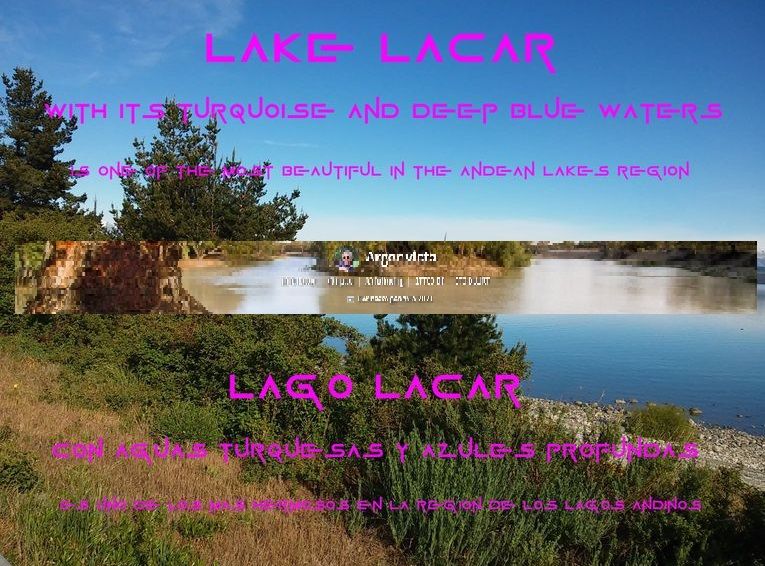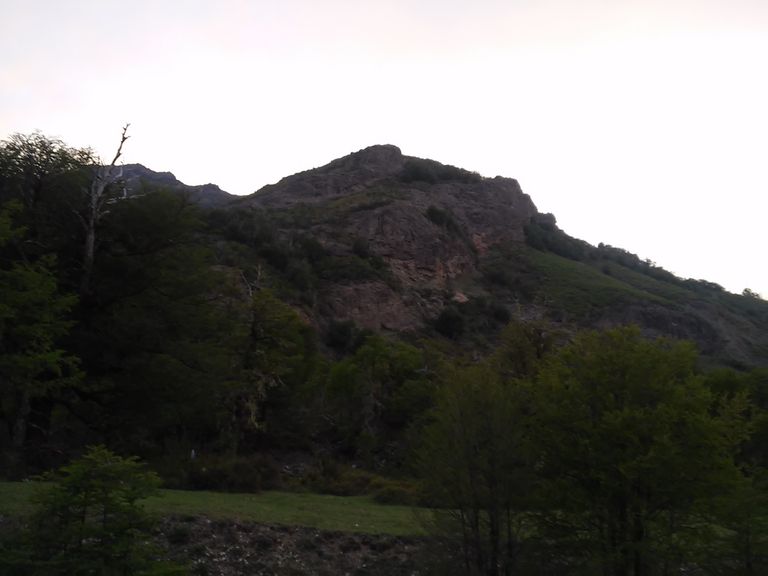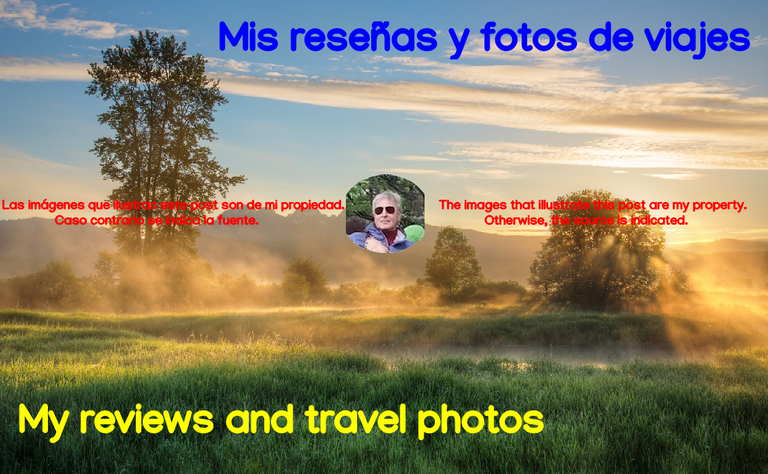


I'll end by telling you my impressions of this beautiful journey we have made with my wife and our faithful masota Zezé along more than 100 kms that make up the so-called Seven Lakes Road in the province of Neuquén, Argentina, and which ends in this case with Lake Lácar, for us who chose the one-way itinerary, let's call it that, which goes from Villa La Angosturas to San Martín de los Andes.

This way of touring the lakes is ideal for those who arrive, for example, in San Carlos de Bariloche and then travel through the Andean Region along Route 40 and other provincial routes and roads, in this case going down towards the city of Neuquén, to then continue towards Buenos Aires, the capital of the country, where most of the tourism that arrives to this region comes from.

For those who do the circuit the other way round, they will find themselves in the city of San Martin de los Andes with Lake Lácar as the starting point of this wonderful itinerary, and then they will find all the other lakes in the opposite direction we have done it, always by car, of course. You will have, however, an advantage: you will find all the panoramic viewpoints on your side, which is why you will avoid making unexpected and very careful manoeuvres when you have to go through the countryside as we did. The rest is exactly the same, nothing changes.

Lake Lácar is not only beautiful for its own configuration as a Patagonian lake of glacial origin, it has a detail that makes it unique: a part of it surrounds the city itself, so you don't even have to go out to the road to appreciate its beauty. At the beginning of the city there is a pedestrian walkway closed to vehicular traffic that surrounds part of the lake, allowing you to admire its spectacular beauty in total comfort. A place to which the inhabitants of San Martin are totally accustomed and that allows us to barely get out of our amazement.

This area called the Costanera del Lago Lacar (actually the Costanera is the characteristic place of the Rio de la Plata in the city of Buenos Aires) was remodelled a decade ago with the project called "Recuperation and Rehabilitation of the Parque Costanera Lago Lacar". Besides allowing a panoramic view of the lake, it has other services of great natural and cultural value, apart from being the access point to the Lanin National Park; the wide beach and bathing area that adds to its conditions as a tourist port for excursions and sports activities; and basically for being the point of close contact with the city and the starting point to travel the Route of the Seven Lakes.
<center
To illustrate what Lake Lácar means to the locals would be like leaving our own house, going a few metres and being able to admire, with a panoramic view, the imposing beauty of one of the most beautiful lakes in the whole Andean Region. A privilege of few, but admired by all tourists who, no matter the time of the year, come to this small town, with some alpine characteristics of those villages nestled in the north of Italy or in the south of Austria and France.

It has a strange shape different from those round water mirrors we are used to see in postcards, the Lácar Lake has an elongated shape in a clear east-west direction and is protected by the Lanín National Park of which it is part, in a deep valley called Vega de Maipú to the east. The whole area is framed within what the Dirección de Parques Nacionales calls a strict area, specially protected and cared for in all its biodiversity and ecosystem.

One of the most beautiful tours is the boat trip across Lake Lácar and Lake Nonthue, its tributary, where the Hua Hum River originates. Along the crossing we see some houses of the Mapuche community, we cross the Yuco peninsula, we pass near the park ranger station, the Isla de los Patos, whose entrance is absolutely forbidden since it is considered a strict fauna reserve, to which only park rangers can have access, and we return by going around Santa Teresita. A beautiful route where we can see the mantle of vegetation that covers the slopes of the Andes Mountains, the tributaries of Lake Lácar with the changing colour of its waters and a supernaturally imposing Andean landscape.

Termino contándoles mis impresiones de este hermoso recorrido que hemos hecho con mi esposa y nuestra fiel masota Zezé a lo largo de más de 100 kms que conforman el llamado Camino de los Siete Lagos en la provincia de Neuquén, Argentina, y que termina en este caso con el Lago Lácar, para nosotros que elegimos el itinerario de ida, llamémoslo asi, que va desde Villa La Angosturas hasta San Martín de los Andes.

Este modo recorrer los lagos es ideal para los que llegan por ejemplo a San Carlos de Bariloche y luego se dedican a recorrer la Comarca Andina a través de la ruta 40 y demás rutas y caminos provinciales, en este caso bajando en dirección a la ciudad de Neuquén, para luego seguir camino en dirección a Buenos Aires, la capital del país, de donde proviene gran parte del turismo que llega a esta región.

Para aquellos que hagan el circuito al contrario se encontrarán dentro de la misma ciudad de San Martínde los Andes con el Lago Lácar como punto de partida de este maravilloso itinerario, y luego irán encontrando todos los restantes lagos en el sentido inverso en que lo hemos hecho nosotros, siempre por supuesto en auto. Tendrán, eso si, una ventaja: encontrarán todos los miradores panorámicos de su lado, razón por la cuál se evitarán hacer maniobras imprevistas y con mucho cuidado al tener que atravesar la rura como hicimos nosotros. El resto es exactamente igual, no cambia nada.

El Lago Lácar no solo es hermoso por su propia configuración de lago patagónico de origen glaciar, tiene un detalle que lo hace único: una parte del mismo rodea la misma ciudad, por lo cuál no hay ni siquiera que salir a la ruta para apreciar su belleza. Al inicio de la ciudad hay una peatonal cerrada al tránsito vehicular que rodea una parte de lago pudiendo admirar su espectacular belleza con total comodidad. Un lugar al que los habitantes de San Martín están totalmente habituados y que a nosotros nos permite apenas salir de nuestro asombro.

Este sector llamado la Costanera del Lago Lácar (en realidad la Costanera es el lugar característica del Rio de La Plata en la ciudad de Buenos Aires) fue remodelado hace una década con el proyecto denominado “Recuperación y Rehabilitación Parque Costanera lago Lacar” ya que además de permitir una visión panorámica del lago cuentra con otros servicios de gran valor natural y cultural, aparte de turístico, como ser el punto de acceso al Parque Nacional Lanín; la amplia zona de playa y balneario que se suma a us condiciones de puerto turístico para excursiones y prácticas deportivas; y básicamente por ser el punto de contacto estrecho con la ciudad y punto de partida para recorrer la Ruta de los Siete Lagos.

Para graficar lo que significa el Lago Lácar para los lugareños sería como salir de nuestra propia casa, hacer unos pocos metros y poder admirar, con una vista panorámica, la imponente belleza de uno de los lagos más hermosos de toda la Comarca Andina. Un privilegio de pocos, pero admirados por todos los turistas que sin importar la época del año se dan cita en esta pequeña ciudad, con algunas características alpinas de esas aldeas encastradas en el norte de Italia o en sur de Austria y Francia.

Tiene una forma extraña diversa a esos espejos de agua redondos que estamos habituados a ver en las postales, el Lago Lácar tiene una forma alargada en clara dirección este a oeste y está protegido por el Parque Nacional Lanín del que hace parte, en un valle profundo que al este se denomina Vega de Maipú. Toda el área está encuadrada dentro de lo que la Dirección de Parques Nacionales llama érea estricta, especialmente protegida y cuidada en toda su biodiversidad y ecosistema.

Uno de los recorridos más hermosos que se pueden hacer es el recorrido en barca para recorrer el Lago Lácar y el Lago Nonthue, su afluente, donde nace el río Hua Hum. A lo largo de la travesía vemos algunas viviendas de la comunidad mapuche, cruzamos la península de Yuco, pasamos cerca de la seccional del guardaparques, de la Isla de los Patos cuyo ingreso está absolutamente prohibido ya que está considerada una reserva faunística estricta a la cuúl solo pueden acceder los guardaparques y regresando dando la vuelta por Santa Teresita. Un recorrido hermoso donde podemos ver el manto vegetal que cubre las faldas de la Cordillera de los Andes, los afluentes del Lago Lácar con el color cambiante de sus aguas y un paisanje andino de una imponencia sobrenatural.


Source background image / Fuente imagen de fondo: Ruta 40.


Sources consulted (my property) for the preparation of this article. Some paragraphs may be reproduced textually.
Fuentes consultadas (de mi propiedad) para la elaboración del presente artículo. Algunos párrafos pueden estar reproducidos textualmente.
| Argentina Discovery. |  |
|---|---|
| Galería Fotográfica de Argentina. |  |
| Viaggio in Argentina. |  |
| Patagonia Express. |  |
